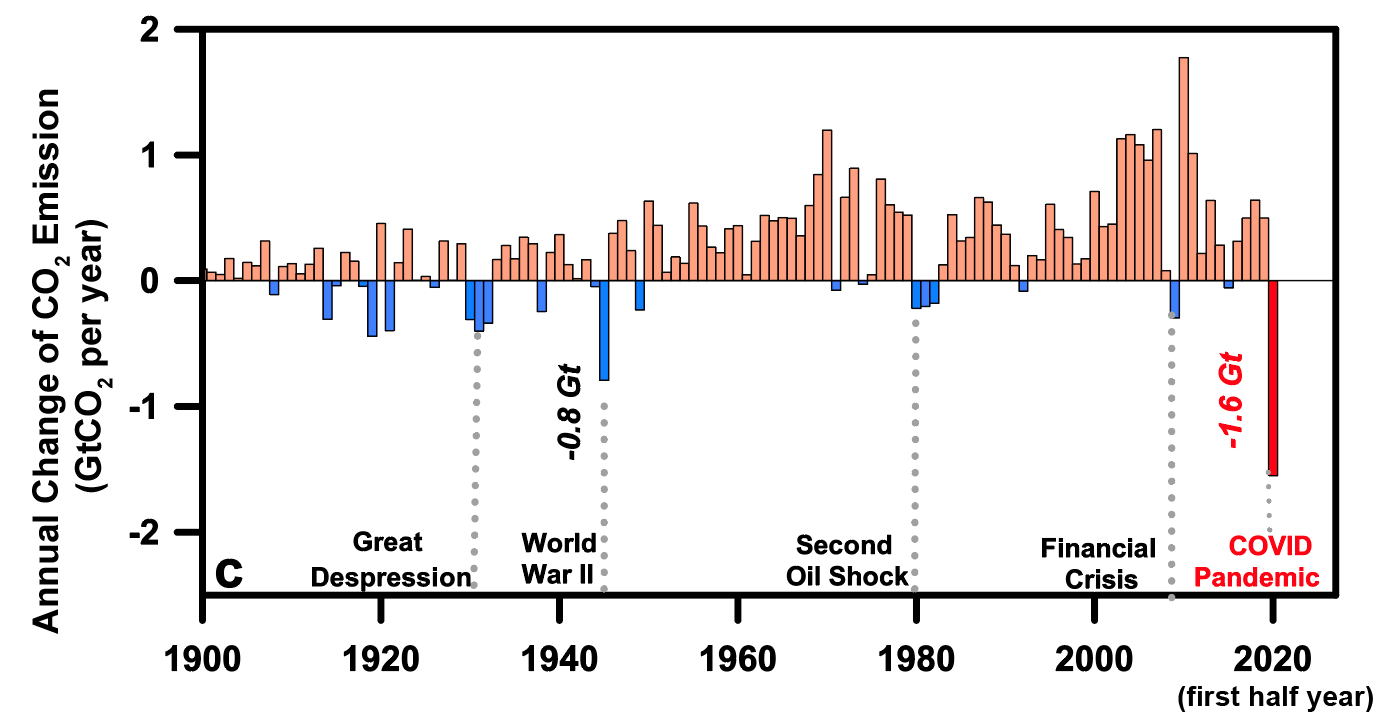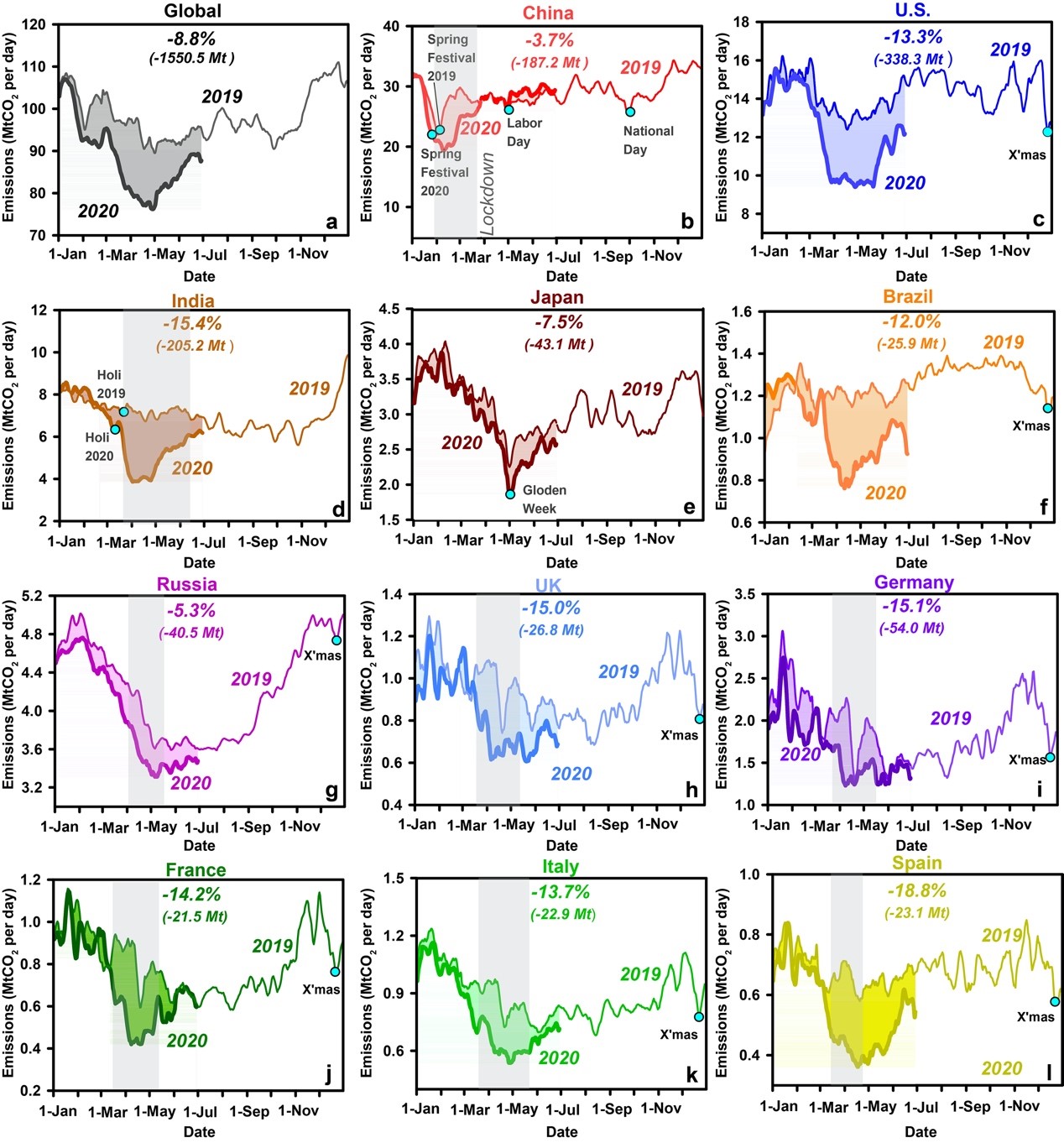Position: Home> Media Center > Industry News

A study led by Liu Zhu, Associate Professor of the Tsinghua Department of Earth System Science, found that the world saw a record 8.8 percent drop in global carbon emissions in the first half year of 2020 compared to the same period last year, as lockdowns were imposed around the world due to the COVID-19 pandemic.
It was the sharpest decline ever, even compared to previous economic downturns or World War II.
The research, entitled "Near-real-time monitoring of global CO2 emissions reveals the effects of the COVID-19 pandemic”, published in the journal Nature Communications on October 14, showed that in April, at the height of the first wave of Covid-19 infections, when many countries imposed severe restrictions on public life and shut down parts of their economy, emissions fell by 16.9 percent, the biggest monthly drop in the first half year.

Fig. Effects of COVID-19 on global CO2 emissions. COVID-19 causes the largest annual decrease of CO2 emission since 1900.
But since July, the pandemic’s effects on global emissions diminished as lockdown restrictions relaxed and economic activities restarted, especially in China and several European countries; but substantial differences persist between countries, with continuing emission declining in the U.S. where coronavirus cases are still increasing substantially, according to the research. The co-first authors are Zhu Liu, an Associate Professor in the Department of Earth System Science of Tsinghua University, Philippe Ciais, a Professor in the Laboratoire des Sciences du Climate et de l'Environnement LSCE of Orme de Merisiers, and Zhu Deng, a doctoral student in the Department of Earth System Science of Tsinghua University.
The researchers analyzed a variety of near real-time activity datasets for different sectors named Carbon Monitor. Carbon Monitor is based on a variety of near real-time activity data, including hourly or sub-hourly electricity generation data from 30 countries, traffic congestion data from over 400 cities worldwide, near real-time flight status, industrial production in over 60 countries and global population-weighted air temperature.

Fig. Daily CO2 emissions for countries. Effects of the COVID-19 pandemic on daily CO2 emissions globally and in each of 11 regions are reflected by the shaded differences between January 1st and June 30th of 2019 and 2020.
In the first half of the year, the research found, the greatest reduction of emissions was observed in the ground transportation sector. Largely because of working from home restrictions, transport CO2 emissions decreased by 40 percent worldwide. In contrast, the power and industry sectors contributed less to the decline, with -22 percent and -17 percent, respectively, as did the aviation and shipping sectors. Surprisingly, even the residential sector saw a small emissions drop of 3 percent; largely because of an abnormally warm winter in the northern hemisphere, heating energy consumption decreased, with most people staying at home all day during lockdown periods.
“What makes our study unique is the analysis of meticulously collected near-real-time data,” said Professor Liu.
The groundbreaking study not only offers a much more precise look at COVID-19’s impact on global energy consumption than previous analyses, but also suggests what fundamental steps could be taken to stabilize the global climate in the aftermath of the pandemic.
Article link: https://www.nature.com/articles/s41467-020-18922-7/
Web link to the Carbon Monitor initiative: https://carbonmonitor.org/
Source: Department of Earth System Science
Editors: Sangeet Sangroula, John Olbrich, Lin Yuan, Guo Lili
 京公网安备 110402430053 号
京公网安备 110402430053 号